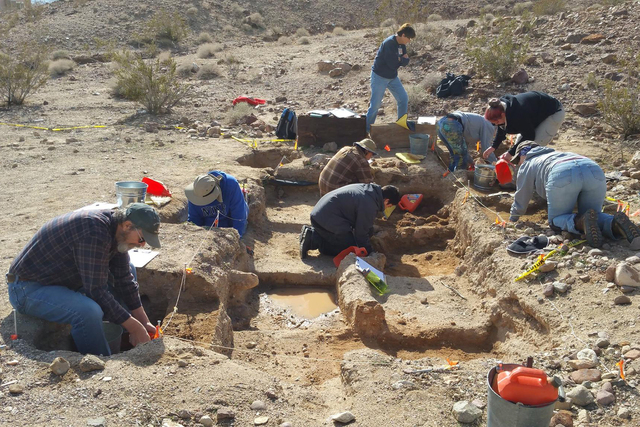Diggers search for signs of early man at Calico site

Volunteers this weekend are busily searching for clues at the Calico Early Man Archaeological Site near Barstow, California. They hope to unearth further evidence of prehistoric hunter-gatherers near the shore of ancient Lake Manix, which has been dry for 18,000 years. The discovery of what appeared to be primitive stone tools at the site in 1942 resulted in scientific turmoil because of the apparent age of the site and the difficulties in sorting artifacts shaped by human hands from the detritus of natural forces moving stone down nearby mountainsides.
The Calico Early Man Site is about 160 miles from Las Vegas west of Interstate 15 not far from Calico Ghost Town, a popular regional park. Turn off the freeway at the Minneola exit and follow a graded road about two miles to the end of the road at a parking area near the Calico Hills. The site is seven miles from Yermo and 15 miles north of Barstow. A small building serves as a visitor center with display room, gift shop, tour assembly area and restrooms.
Now under Bureau of Land Management administration, the 500-acre archaeological site is open for guided tours from 9 a.m. to 4 p.m. on Saturdays. For information on tours, call 760-218-6931. Nominal fees are charged for the tour, which usually takes less than an hour. A short uphill trail leads to the dig site and fairly level walkways continue through the excavations, where work may be in progress. Participants should wear sturdy closed shoes, dress in layers and use sunblock, as part of the tour will be in full sun. Bring bottled water.
The archaeological preserve has active boosters in the nonprofit group, Friends of the Calico Early Man Site. The organization assists with guided tours and sponsors digging sessions on the first full weekend each month from October through May. The volunteers instruct the diggers on excavation techniques, record-keeping, site maintenance and recognizing the difference between stone that has been flint-knapped and water-tumbled rock shards. The diggers usually number at least a dozen and often more than two dozen people of all ages who are eager to get their hands dirty. Many camp at the site during the work session. The last working weekend this spring is scheduled for May 7 and 8.
Visitors must imagine the area as it was long ago to understand the significance of the Calico Early Man Site. The Mojave Desert that surrounds them today did not exist. Once it was well-watered and verdant around Lake Manix with many animals grazing on lush grasslands, trees full of birds, fish swimming in the lake and waterfowl floating and diving in the water. Such an abundance of prey and other food sources was bound to attract predators, including early human hunters.
Since its discovery by amateur archaeologists, the site has generated conflicting conclusions. Many scientists lean toward identifying the spot as a work site for hunters shaping stone tools, perhaps seasonally occupied. They theorize that early flint-knappers used stone that washed from the mountains toward the lake. Over time, the ancient alluvial fan solidified into rock layers where the volunteers work in trenches today to find rock cores, broken stone points and sharp chips trapped in the solidified sediment. So far no discoveries of human remains have been made, which fuels opposing views. Skeptics maintain that most of what has been found is probably the result of natural forces breaking up stone as it tumbled from the mountains.
In 1954, San Bernardino County archaeologist Ruth Simpson took some artifacts unearthed at the site to renowned scientist Louis Leakey, discoverer of early man sites in Africa’s Olduvai Gorge. Leakey arranged financing for more work at the site through the National Geographic Society. He visited the desert site frequently from 1964 until his death in 1970, serving as project manager. Simpson spent decades there until her death in 2000.
If enough evidence can be found at the Calico Early Man Site to substantiate the claims, it would be the earliest site yet discovered in the Western Hemisphere. However, many scientists balk at the tests that suggest improbably early evidence of artifacts created 135,000 to 200,000 years ago.
Margo Bartlett Pesek’s Trip of the Week column appears on Sundays.












